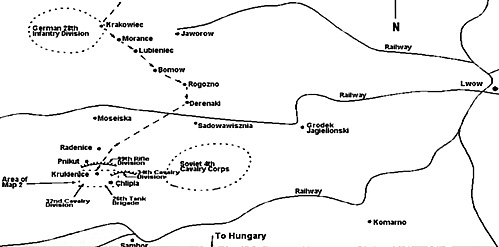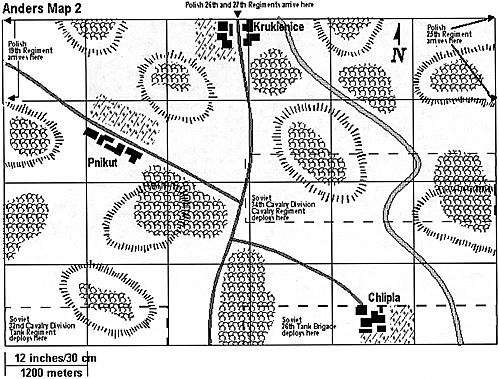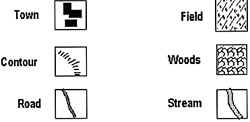An important element in the Soviet strategy was to seal off Poland's borders with Rumania and Hungary, across which many Polish units sought to escape in late September. By 23rd September the Soviets had reached Lwow. Their continued advance obstructed the escape of General Wladislaw Anders' Operational Cavalry Group.
This Group was the largest Polish cavalry formation formed during the German invasion of Poland. It was created on 1th September 1939 with the Nowogrodzka Cavalry Brigade as its core, to which were added a miscellany of other battered units including: remnants of the Kresowa Cavalry Brigade; elements of the 4th and 14th Regiments from the Wilenska Cavalry Brigade; and remnants of the Wolynska Cavalry Brigade, which had given the 4th Panzer Division a bloody nose at Mokra at the start of the campaign.
To describe its two week career briefly: "Group Anders brok out of Warsaw near Minsk Mazowiecki on 13 September. It was then ordered to Parczew region. Reached Deblin area by 17 September. Came under air attack on 20 September. By 22 September, Anders had added to it COL A. Zakrzewski's combined brigade, remnants of the 10th Infantry Division, and elements of the Mazosiecka Cavalry Brigade, and was attacking near Suchowola and Majdan Sopocki on 22 - 23 September. Reached Ruda Rozaniecka by 24 September. Fought near Krasnobrod and Ciotusza. Continued southeastward and fought near Broszki on 26 September. Disbanded by 28 September, with some elements reaching Hungary." (Zaloga & Madej).
Group Anders first ran into the Red Army on 26 September at Derekaki and Leczesne. On the 27th Anders found his force surrounded by Germans and Soviets. His own account is quoted by Piekalkiezicz: "At sunrise on September 27, I decided that we should nevertheless press on, endeavouring to slip through between the Germans and the Russians. During the attempt, we encountered a strong Soviet force which immediately opened fire with artillery. Then the first tanks appeared. Our 9th Regiment of horse artillery returned the fire, demonstrating their well-known accuracy. The 9th Regiment, together with our anti-tank weapons,, succeeded in destroying a good number of Soviet tanks. But by now the heavily armed Russian hordes were attacking us ever more heavily from the rear. The artillery fired off their last rounds; likewise our small arms ammunition was exhausted. There were no field-dressings. The horses had gone without food and water for a long time. We had no alternative but to split up into small groups and make our way through the forests under cover of night, trying to reach Hungary." On 29 September General Anders was captured by a unit of the Soviet 12th Army at Jesionka Sleciowa, from where he was sent to imprisonment in Moscow.
The wargame scenario persented here attempts to recreate this last desperate action of 27 September. The wargame starts after Anders' force has infiltrated through and around the 99th Rifle Division, which is therefore not represented.
Scenario start: 1200, 27 September 1939.
Ground: Map 2 shows the tabletop terrain to be used in the scenario. The gentle hills are the foothills of the Beskid mountains, which nestle up against the Carpathians. The numerous patches of forest are dense and give General Anders' men a chance of slipping through the Soviet lines.
Polish Mission General Anders himself must escape off the south edge of the game board, as must as many of his troops as possible.
Group Anders, a brigade-sized formation that contains the amalgamated remnants of five cavalry brigades, grouped into four weak cavalry regiments.
1 Brigade HQ Squadron, with: Note: The Cavalry Regiments are: the 19th (General E. Rozycki's Wolynski Lancers); the 25th (Wielkopolski Lancers), 26th (Hetman K. Chodkiewicz's Wielkopolski Lancers), and the 27th (King Stefan Batory's Lancers) Regiments.
All troops are in good morale and skill level, (Tac Rating = 5 except for Tankettes, whose Tac Rating = 6), except that, due to poor communications, the Brigade HQ's Tac Rating = 8 when trying to change regiments' orders.
Polish Historical Deployment: As noted on Map 2. Brigade troops attached to the Cavalry Regiments start the game deployed with those regiments. Troops all start in whatever mode the Polish player desires. The Polish player also may issue battalion orders (to the regiments) before the start of the game.
Prevent the escape of any Polish troops off the south edge of the game board.
1 Cavalry Regiment from the 34th Cavalry Division, with: 1 Tank Regiment (depleted) from the 32nd Cavalry Division, with: 2 Tank Regiments from the 26th Tank Brigade, each with: All troops are of average morale (Tac Rating = 7).
Soviet Historical Deployment: As noted on Map 2. Troops all start in Default or Defense mode as determined by the Soviet player. The Soviet player also may issue battalion orders before the start of the game.
Limited Intelligence: This scenario requires a third person to umpire for the two opposing players. Both sides should operate with very limited intelligence about each other's initial troop dispositions. Three ways to achieve this are:
1. Hidden Movement This requires the referee to confer with the players secretly, to use map movement, and to place troops on the table only when they are located by the enemy. Advantage: the most effective way to limit the knowledge available to the players. Disadvantage: the slowest and most cumbersome method to administer.
2. Formation Cards Give each player 10 cards about 10cm/.4in square. Each card may represent between 0 and 12 elements (models or troop stands),i.e. some may be "dummy" markers. Players deploy the cards instead of elements at game start. Cards move at the speed of the slowest troops represented (or at the speed of any elements in their forces if dummies). Soviet dummies may be deployed anywhere at least 50cm/20 in. from the north board edge. Replace the cards with troops when they're located. Advantage: allows some active deception by imaginative use of dummies; relatively quick, Needs no umpire if actual units are listed on back of the card for review by your opponent. Disadvantage: visually unattractive.
3. Dummy Troops If you have enough figures available, give both players twice as many troops as they actually possess and let them deploy them all but secretly note which are real. Remove dummies as they are located. Soviet dummies may be deployed anywhere at least 50cm/20 in. from the north board edge. Advantage: allows active deception; visually attractive. Disadvantage: requires you to possess 8 regiments of Polish cavalry! (We used method 2.)
Polish Infiltration and Casualties From Snitko-Rzeszut's map, it appears as though the flank regiments (the 19th and 25th) worked their way around the flanks of the 99th Rifle Division without too much trouble, but that the 26th at least suffered an initial repulse. For the purposes of this scenario, every Polish element entering the game board from the north edge is therefore treated as having a risk of repulse and must pass a Tac roll per element to arrive. Detection/Location: Because of the confused situation, with German, Polish, and Soviet forces all in the same area, use the optional detection/location rule from Tac:WWII, especially for identifying forces initially. For other rule systems try halving the normal detection distances or reduce spotting chances appropriately.
Victory: If Anders escapes off the south game board edge, the Poles win. If he doesn't, the Soviets win.
After Germany invaded the Soviet Union in 1941, Anders was given the job of mustering a new Polish Army to fight alongside the Red Army. Eventually, however, he persuaded Stalin to transfer him to Persia with enough fellow Poles to raise the new Polish II Corps. In February 1944, Anders' II Corps landed in Italy to take part in the battle for Monte Cassino.
Piekalkiewicz, J.; The Cavalry of World War II; Orbis: London 1979. A "popular" treatment but full of fascinating nuggets.
Further Reading
For those interested in more scenarios set in the Polish Campaign, you will find eleven (six linked in a mini-campaign) in "Fall Weiss": Poland 1939, the first published supplement to Tac:WWII (others are now available). Both Tac:WWII and "Fall Weiss" are published by Tac Publications and distributed by Irregular Miniatures, 3 Appolo Street, Heslington Road, York, England YO10 5AP, for £6 and £5, respectively, plus shipping.
 The Red Army invaded Poland 16 days after Germany attacked, on 17th September 1939. The invasion was carried out by the Byelorussian and Ukrainian Fronts, with 24 infantry divisions, 15 cavalry divisions, 2 tank corps, and several tank brigades. It was totally unexpected by the Polish command, who had been hoping for a quite different intervention - a French counteroffensive against the Germans. Poland's eastern frontiers were lightly guarded by KOP (frontier defense) units, but many of these had been drawn west to fight the Germans. Polish resistance to the Soviets was further hampered by confusion: Polish troops often welcomed the Soviets, thinking they were coming to help fight the Wehrmacht.
The Red Army invaded Poland 16 days after Germany attacked, on 17th September 1939. The invasion was carried out by the Byelorussian and Ukrainian Fronts, with 24 infantry divisions, 15 cavalry divisions, 2 tank corps, and several tank brigades. It was totally unexpected by the Polish command, who had been hoping for a quite different intervention - a French counteroffensive against the Germans. Poland's eastern frontiers were lightly guarded by KOP (frontier defense) units, but many of these had been drawn west to fight the Germans. Polish resistance to the Soviets was further hampered by confusion: Polish troops often welcomed the Soviets, thinking they were coming to help fight the Wehrmacht.
Wargaming the Battle
Scenario finish: 1720 (dusk) 27 September 1939.(16 turns if played using Tac:WWII)
Weather: good.
Visibility: clear.
Battle Picture: Group Anders needs to break through to the south to reach Hungary; units of the Soviet 6th Army are moving up to oppose it. Map 1 shows the general situation before the action: Group Anders around Radenice facing the Soviet 99th Rifle Division, itself deployed north of Krukienice. To the 99th's right rear, a cavalry regiment of the Soviet 34th Cavalry Division is deployed north of Chlipla, supported by elements of the 26th Tank Brigade around Wladypol. To the 99th's left rear, a tank regiment of the 32nd Cavalry Division approaches from Rajtarowice (adapted from Snitko-Rzeszut, pg. 151).
Polish Order of Battle
1 HQ Cavalry Platoon (General Anders)
2 Escort Cavalry Platoons
1 Bicycle Company (attachable to any rgt.), with 2 Bicycle Platoons
1 Antitank Company, (attachable to any rgt), with 2 Bofors 37mm ATG
1 Engineer Squadron, (attachable to any rgt), with 2 Engineer Cavalry Platoons
1 Tankette Squadron, (attachable to any rgt), with 2 PK Tankette Platoons
4 Cavalry Regiments, each with 1 HQ Cavalry Platoon
4 Cavalry Squadrons, each with 2 Cavalry Platoons
1 Taczanka Platoon (MMG on horse drawn carriage)Soviet Mission
Soviet Order of Battle
1 HQ Cavalry
1 Heavy Weapons Squadron, with: 1 76.2mm howitzer, horse-drawn
2 Cavalry Battalions, each with
1 45mm antitank gun, horse-drawn
5 MMG platoons1 HQ Cavalry Platoon
3 Cavalry Squadrons, each with 2 Cavalry Platoons1 HQ BT7 Platoon
3 Tank Companies, each with 3 BT7 Platoons1 HQ T26 Platoon
3 Tank Companies, each with 2 T26 PlatoonsEpilogue
Bibliography
Snitko-Rzeszut, J.; Wojna Obronna Polski (Poland's Defensive War of 1939); Wojskowy Instytut Historyczny: Warsaw, 1995. An atlas of the campaign with some 80 colour maps, each with facing text in Polish and an English summary. Invaluable (especially in combination with a Polish dictionary!).
Zaloga, S. & Madej, V.; The Polish Campaign 1939; Hippocrene: New York, 1991. Recognized as the most comprehensive treatment of the campaign available in English. A wealth of scenarios could be written just from the information in this book and the atlas.


Back to Table of Contents -- Courier #77
To Courier List of Issues
To MagWeb Master Magazine List
© Copyright 1999 by The Courier Publishing Company.
This article appears in MagWeb (Magazine Web) on the Internet World Wide Web.
Other military history articles and gaming articles are available at http://www.magweb.com